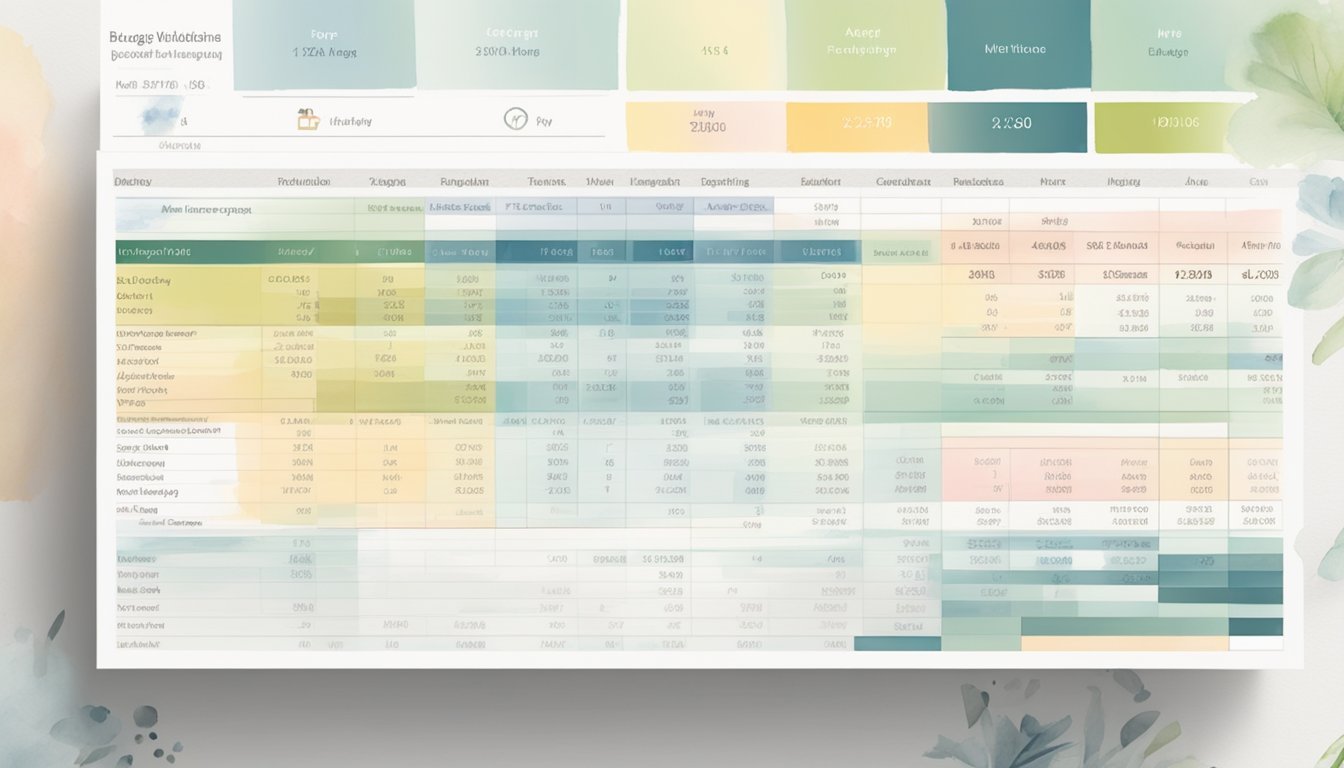7 Steps to a Perfect Wedding Budget: Your Ultimate Planning Guide

Planning a wedding can be both exciting and overwhelming, especially when it comes to managing your finances.
Creating a wedding budget is a crucial step to ensure your big day is both memorable and financially manageable. Knowing how to allocate your funds effectively can save you from unnecessary stress and unexpected costs.

In this guide, we will walk you through a simple approach to maintaining a budget for your wedding.
You’ll find tips and strategies to help you make the most of your budget while still achieving the wedding of your dreams.
This includes everything from guest list management to selecting the best date and time for your ceremony.
1) Determine Your Total Budget

Start by figuring out how much money you have for your wedding.
This includes any contributions from family members, savings, or even loans.
Knowing your total budget helps set the stage for all your planning.
Make sure to think about any hidden costs or extra fees that might come up.
This can include taxes, tips, or emergency funds.
Being prepared will save you stress later on.
Break your budget into categories.
Common categories include venue, catering, attire, and entertainment.
Each category should have its own budget to ensure you don’t overspend in any one area.
Consider how many guests you plan to invite.
More guests will increase your costs due to extra food, seating, and favors.
Online tools like the wedding budget calculator can help you see per-person costs based on your guest count.
Remember to save some of your budget for unexpected expenses.
These might be last-minute changes, additional decor, or unforeseen service fees.
Allocating a small percentage of your budget as a cushion can be very helpful.
If you’re still unsure about how to allocate funds, you can look at wedding budget breakdowns for guidance.
These examples can provide good starting points and help you figure out where your money should go.
By clearly determining your total budget, you set a strong foundation for planning the rest of your wedding.
Keep track of every expense to stay within your means and avoid financial stress.
2) Track Expenses in Real-Time

Keeping track of your wedding expenses in real-time is crucial.
By monitoring your spending as it happens, you can ensure you stay within your budget and avoid surprises.
One effective way to do this is by using a budget worksheet.
A worksheet helps you track income, expenses, and payments.
It’s a systematic way to see where your money is going.
Another useful tool is a cash tracking app.
These apps allow you to record your expenses immediately.
Some popular options are specifically designed for wedding planning and can simplify the whole process.
You can also use a wedding planning binder.
This method is great for those who prefer something tangible.
A binder keeps all your receipts, invoices, and budgeting notes in one place.
Consider downloading a wedding budget spreadsheet.
These spreadsheets are user-friendly and help you organize your finances with ease.
They come with templates that are pre-filled with common expense categories.
Using an Excel Wedding Budget Spreadsheet can transform your planning.
This spreadsheet ensures every aspect of your big day is beautifully managed.
It’s a comprehensive tool for managing and planning.
By consistently updating your expenses, you’ll get a clear picture of where your money is going.
This helps you make informed decisions about your wedding finances.
Remember to regularly review your budget.
Consistent monitoring allows you to adjust your spending as needed.
Your wedding finances will stay on track, ensuring a stress-free planning process.
3) Allocate Funds to Key Areas
Start by deciding how much you can realistically spend on each part of your wedding.
Some categories will need more money than others.
Set aside 10% of your budget for music and entertainment.
This includes hiring a DJ or live band.
Flowers and decorations often take up another 10%.
This covers bouquets, centerpieces, and ceremony décor.
Wedding attire and beauty typically require 5% of your budget.
This includes your dress, suit, makeup, and hair.
Transportation costs usually account for 3%.
This might involve renting limos or other vehicles.
Budget around 2-3% for wedding stationery like invitations, save-the-dates, and thank you cards.
Don’t forget about favors and gifts, which also take up about 2% of your budget.
This includes small gifts for guests and your wedding party.
Allocating funds carefully ensures that each part of your wedding gets the attention it deserves.
This approach helps you stay on track without overspending.
Consider using a wedding budget calculator to help manage these allocations.
It eases the process of tracking your budget.
By breaking down your budget into these key areas, you make sure all the important elements are covered.
This method keeps your spending balanced and organized, leading to a successful wedding day.
4) Set Aside an Emergency Fund

Unexpected expenses can happen during wedding planning.
To avoid stress, it’s smart to set aside a portion of your budget for emergencies.
Allocate about 5-10% of your total budget for this fund.
This will cover last-minute changes or additions.
For example, if your budget is $20,000, reserve $1,000 to $2,000 for emergency situations.
This helps you stay prepared for any surprises.
You never know what could come up: changes in weather, vendor cancellations, or unexpected guests.
An emergency fund ensures you can handle these issues.
Saving for contingencies gives you peace of mind.
It allows you to focus on enjoying your special day.
To learn more tips on setting aside an emergency fund, visit this guide.
5) Plan for Tipping Costs

Tipping your wedding vendors is an essential part of the budget.
You should prepare for these costs early to avoid last-minute surprises.
It’s a great way to show appreciation for their hard work.
For your hair and makeup services, it’s customary to tip between 15-25% of the service cost.
If your artist goes above and beyond, consider giving 25% as a thank you.
When it comes to catering staff, bartenders, and waiters, a tip of around 15-20% of the total bill is standard.
These workers often depend on tips, so factoring this into your budget is important.
Photographers and videographers usually receive a tip of $50-$200.
This amount can vary based on their service quality and the length of time they spent with you.
For your DJ or band, plan to tip $50-$150 per person.
If they did an exceptional job keeping the party alive, a higher tip is a nice gesture.
Don’t forget about your wedding planner.
A tip of $100-$500 is common, depending on the extent of their involvement and the level of detail they managed.
Prepare individual envelopes for each vendor who will receive a tip.
Hand these out during or at the end of the event to ensure each vendor knows you appreciate their efforts.
To make the process smoother on your wedding day, assign the task of distributing these tips to a trusted person, like a family member or member of the wedding party.
Tipping costs can add up quickly, so it’s crucial to allocate enough in your budget to cover these expenses.
For more details, check out The Ultimate Guide to Tipping Wedding Vendors.
6) Prioritize High-Impact Elements

Start by identifying the most important aspects of your wedding.
These elements should align with what you and your partner both value most about the day.
Discuss which parts of the event will make the biggest impact on your experience.
For example, you might prioritize venue and catering, which often take up around 50% of the budget.
This aligns with advice from Brides on a Budget.
Next, consider what guests will notice most.
Many couples spend more on photography and music, as these are key components people remember.
Allocate a portion of your budget to non-negotiables.
These could include meaningful items like wedding rings or a special dress, as mentioned by WedWhimsy.
Think about the atmosphere you want to create.
If ambience is crucial, prioritize décor and lighting.
Evaluate each high-impact element separately.
This helps ensure you spend wisely and stay within your overall budget, as suggested by Finnable.
By focusing on these high-priority items, you can make strategic decisions that enhance your wedding without overspending.
7) Review and Adjust Monthly

It’s essential to check your wedding budget regularly.
Set aside time each month to review your expenses.
This habit helps you stay on track.
Look at every category in your budget.
See if you spent more or less than planned.
If something is over budget, find ways to cut costs in other areas.
Make adjustments as needed.
Maybe you saved money on decorations but spent more on catering.
Shift some of the saved money to cover the extra catering expenses.
Talking about your budget with your partner is crucial.
It ensures you both know where your money is going.
Use budgeting tools to help.
Some tools can track your spending and alert you to overages.
Monthly reviews keep your budget accurate.
As prices change, so can your budget.
For example, if you find a better deal on flowers, update your budget to reflect the savings.
Don’t forget to adjust for unexpected costs.
Weddings can have surprises.
Having a buffer in your budget can help manage these surprises without stress.
Regular check-ins make the budgeting process less overwhelming.
It breaks it into manageable pieces, making it easier to handle.
Regular reviews ensure your wedding day stays within the financial plan you’ve set.
Understanding Wedding Financing
A well-planned wedding budget involves setting financial priorities and identifying various funding sources.
Here’s what you need to know to get started.
Setting Financial Priorities
Deciding which aspects of your wedding are most important will help you allocate your funds effectively.
Start by listing what you can’t compromise on, like the venue, dress, or catering.
Next, identify areas where you can cut costs, such as decor or wedding favors.
Discuss these priorities with your partner and family members who might be contributing.
Agreeing on what’s essential helps prevent overspending in less important areas.
Make sure your high-priority expenses are covered first and adjust other parts of the budget as needed.
Using a financial planner or budgeting tool can also help keep your spending on track.
Regularly review your expenses to ensure you’re sticking to your plan.
Sources of Wedding Funds
Identifying where your wedding money will come from is crucial.
Common sources include personal savings, family contributions, and even loans.
Start by assessing your savings and determining what you can comfortably spend without jeopardizing your financial stability.
Family contributions often play a significant role.
Have open and honest conversations with family members who may be willing to help.
Understanding their level of contribution will help you better plan your budget.
Some couples also consider personal or wedding-specific loans as a last resort.
Be cautious with this option, as it can lead to longer-term debt.
Consider all pros and cons before deciding to borrow money.
Knowing all your funding sources helps you create a more realistic and manageable wedding budget.
Allocating Your Wedding Budget
To allocate your wedding budget effectively, you need to estimate costs accurately and balance your needs and wants.
Careful planning helps you avoid unexpected expenses and ensures a smooth wedding experience.
Estimating Costs
Start by listing all potential expenses, such as venue, catering, and attire.
It’s essential to include even small items like invitations.
Use online tools or seek advice from recently married friends to gauge typical prices in your area.
For example, venues generally consume a significant portion of the budget, often between 30% to 50%.
Consider the number of guests when estimating catering costs.
A general rule is to budget at least $100 per guest.
When it comes to attire, allocate around 7% for the wedding dress and suit.
Don’t forget extra costs like shoes and accessories.
Balancing Needs and Wants
Distinguish between essential elements and nice-to-haves.
Essentials include the venue, catering, and officiant, which are non-negotiable.
Wants are additional touches like ornate centerpieces or a live band.
Prioritize your list, placing the most critical expenses at the top.
If you need to cut costs, consider reducing the guest list or opting for a less formal venue.
Smaller weddings save on food and other per-guest expenses.
You can also look into DIY options for décor or favors to trim the budget.
Clear prioritization ensures that crucial aspects are funded without compromising your vision.

